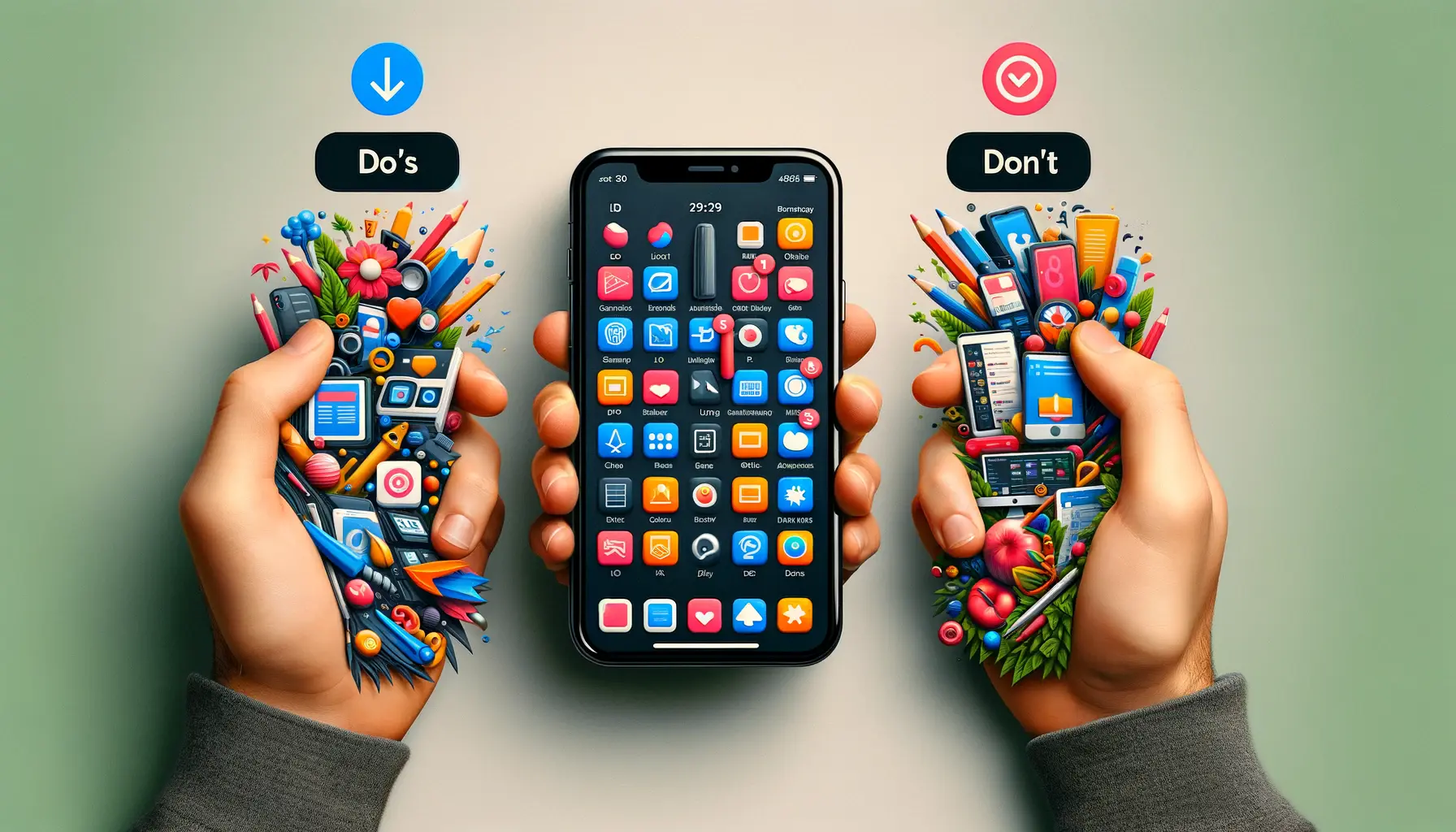App Store Optimization (ASO) is an essential strategy for developers aiming to enhance their app’s visibility and attract more downloads in an increasingly crowded marketplace.
As mobile usage continues to surge, the significance of ASO has never been more pronounced.
A critical aspect of ASO that often goes overlooked is the optimization of screenshots, which play a pivotal role in converting app store page visits into downloads.
This article delves into the strategic incorporation of keywords in ASO screenshots, a tactic that could significantly boost an app’s visibility and appeal to potential users.
By understanding the nuances of screenshot SEO within ASO, developers and marketers can leverage this powerful tool to create a compelling narrative around their app.
Unlike traditional text-based SEO, screenshot SEO requires a unique blend of creativity and strategic keyword use.
It’s not just about making your app found; it’s about making it irresistible at first glance.
Through careful planning and execution, screenshots can tell a compelling story of your app’s value proposition, directly impacting download rates.
- Understanding ASO and Its Importance
- Effective Keyword Research for ASO
- Optimizing App Title and Description
- Designing Compelling App Screenshots and Videos
- Boosting App Visibility Through Reviews and Ratings
- Localizing Your App for Global Reach
- Monitoring and Analyzing ASO Performance
- Maximizing Your App’s Potential with ASO Screenshot SEO
- ASO Screenshot SEO FAQs
Understanding ASO and Its Importance
App Store Optimization, or ASO, refers to the process of optimizing mobile apps to rank higher in an app store’s search results.
The higher your app ranks, the more visible it becomes to potential users, which in turn increases the likelihood of your app being downloaded.
Just like search engine optimization (SEO) for websites, ASO plays a critical role in enhancing your app’s online presence.
ASO is not just about gaining a top spot in search rankings; it’s also about making sure your app meets the app store’s guidelines, using the right keywords, and creating a visually appealing listing with compelling screenshots and videos.
The aim is to not only attract but also engage and convert users by providing them with a clear understanding of what your app offers from the moment they see your app in their search results.
Role of Keywords in ASO
Keywords are the foundation of ASO, serving as the link between what users search for and your app.
Incorporating the right keywords into your app’s title, description, and even in the screenshots can significantly enhance your app’s searchability.
Keyword research helps in identifying the terms potential users are entering into the app store search bar, enabling you to tailor your app’s listing to meet these search queries.
However, the challenge lies in selecting keywords that are not only relevant but also competitive enough to drive visibility without being too generic.
The strategic placement of these keywords in your app’s listing, including the screenshots, plays a pivotal role in improving your app’s discoverability.
This is where screenshot SEO comes into play, marrying visual appeal with keyword optimization to create a powerful ASO tool.
Using keywords effectively in your ASO strategy can dramatically improve your app’s visibility and download rates.
Effective Keyword Research for ASO
Conducting effective keyword research is a cornerstone of a successful ASO strategy.
It involves identifying the terms and phrases potential users are likely to use when searching for apps similar to yours.
This process not only helps in understanding the market demand but also in gauging the competitive landscape within the app store.
Here are the steps and considerations to take when conducting keyword research for ASO:
- Understanding Your Audience: Know who your target users are, including their interests, needs, and the language they use. This helps in crafting a keyword list that resonates with them.
- Analyzing Competitors: Look at apps that are similar to yours and identify the keywords they are targeting. This can provide insights into what works and how you can differentiate your app.
- Using Keyword Research Tools: Leverage ASO tools like App Annie, Sensor Tower, or Mobile Action to uncover high-volume keywords with lower competition. These tools can offer valuable data on keyword popularity and ranking difficulty.
- Considering Long-tail Keywords: Incorporate longer phrases that are more specific but less competitive. These can often attract a more targeted user base and improve conversion rates.
- Regularly Updating Keywords: The app market is dynamic, and user search behaviors change. Regularly revisiting and updating your keyword strategy is crucial for maintaining and improving your app’s visibility.
Selecting the Right Keywords for Your Screenshots
Once you have a solid list of keywords, the next step is to integrate them into your app’s ASO strategy, particularly in your screenshots.
However, this requires a careful balance between maintaining visual appeal and enhancing searchability.
Tips for incorporating keywords into your screenshots:
- Use Captions Wisely: Embedding keywords into the captions of your screenshots can make them more discoverable while providing context to the visuals.
- Highlight Features: Use keywords that highlight your app’s key features and benefits in the screenshot captions or annotations.
- Be Subtle: The primary focus of your screenshots should be to showcase your app’s value. The incorporation of keywords should not detract from this goal.
- Test and Iterate: Experiment with different keywords and monitor how changes affect your app’s visibility and download rates. Use A/B testing to find the most effective keyword and screenshot combinations.
Incorporating keywords into your screenshots is an art that combines SEO strategies with creative design to capture user attention and improve ASO performance.
Optimizing App Title and Description
After identifying the right keywords through meticulous research, incorporating them into your app’s title and description is the next critical step.
The title and description not only inform potential users about your app but also play a significant role in ASO by influencing your app’s search rankings.
Here’s how to optimize them for maximum impact:
Creating a Compelling App Title
The title of your app should be concise, memorable, and inclusive of your main keyword.
A well-crafted title not only captures the essence of your app but also enhances its discoverability in app store searches.
Remember:
- Keep it Short: App store algorithms favor shorter titles. Try to include your main keyword while keeping the title under 30 characters.
- Be Descriptive: Your title should give users a clear idea of what your app does. Incorporate keywords that reflect your app’s core functionality.
Writing an Informative and Engaging Description
The description of your app is where you can expand on what your app offers, highlighting features, benefits, and any unique selling points.
To optimize your app’s description:
- Start Strong: The first few lines of your description are crucial. Make sure to incorporate key phrases and benefits early on to catch the reader’s attention.
- Use Keywords Naturally: Integrate your researched keywords throughout the description in a way that reads naturally. Avoid keyword stuffing as it can negatively impact the user experience and your app’s credibility.
- Highlight Key Features with Bullet Points: Use bullet points to make your app’s key features stand out. This not only improves readability but also allows for the natural inclusion of keywords.
- Include a Call to Action: Encourage users to download or learn more about your app with a compelling call to action at the end of your description.
Optimizing your app’s title and description is a balancing act between being informative, keyword-rich, and user-friendly. The goal is to enhance your app’s visibility while compelling users to download.
Designing Compelling App Screenshots and Videos
The visual elements of your app listing, particularly the screenshots and videos, are incredibly influential in a user’s decision to download.
These visuals not only have to be eye-catching but also informative, effectively communicating what your app does and its benefits.
Here’s how to ensure your screenshots and videos work hard for your ASO:
Creating Engaging App Screenshots
Screenshots are the first visual contact potential users have with your app, making them a critical element in conveying your app’s utility and appeal.
To design screenshots that captivate and inform:
- Showcase Key Features: Highlight the most valuable features of your app. Each screenshot should convey a specific benefit or feature, providing a visual narrative of your app’s user experience.
- Use Descriptive Captions: Incorporate brief, descriptive captions within your screenshots. This helps to contextualize the images and can be a subtle way to weave in keywords.
- Maintain Brand Consistency: Ensure your screenshots reflect your brand’s visual style, using consistent colors, fonts, and imagery. This helps to build recognition and trust.
Utilizing Videos for Deeper Engagement
A well-produced video can provide a dynamic overview of your app, showcasing functionality and user experience in a way static images cannot.
To leverage videos effectively:
- Keep It Short and Sweet: Aim for a video length of 30 seconds to one minute. Highlight your app’s core features in a concise, engaging manner.
- Focus on the First Few Seconds: Grab the viewer’s attention in the first few seconds with compelling visuals and key benefits to keep them watching.
- Include a Call to Action: End your video with a clear call to action, encouraging viewers to download your app.
Well-designed screenshots and engaging videos can significantly enhance your app’s download rate by providing potential users with a clear understanding of your app’s value and functionality.
Boosting App Visibility Through Reviews and Ratings
Reviews and ratings are not just feedback mechanisms; they are influential factors in an app’s ASO strategy.
High ratings and positive reviews can significantly enhance your app’s visibility and attractiveness to potential users.
Here’s how to encourage and leverage reviews and ratings for ASO:
Encouraging User Reviews
Actively encouraging users to leave reviews can be a game-changer for your app’s visibility.
Consider the following strategies:
- In-App Prompts: Implement timely in-app prompts that kindly ask users to rate your app. Timing these prompts can be crucial — consider asking after a positive interaction within the app.
- Respond to Reviews: Engage with users by responding to their reviews, both positive and negative. This interaction not only shows that you value user feedback but can also turn negative experiences into positive ones.
Leveraging Ratings for ASO
Your app’s overall rating is a direct reflection of its quality and user satisfaction.
To maintain high ratings:
- Focus on User Experience: Continuously improve your app based on user feedback to enhance their overall experience. A great user experience is often the best strategy for securing high ratings.
- Monitor Trends: Keep an eye on your app’s ratings trends. A sudden drop could indicate recent issues, such as bugs introduced in the latest update, requiring immediate attention.
High ratings and positive reviews not only improve your app’s ASO performance but also serve as social proof to potential users, significantly impacting their download decisions.
Localizing Your App for Global Reach
App localization goes beyond mere translation; it’s about culturally adapting your app to meet the language, preferences, and nuances of users in different regions.
Localization can drastically improve your app’s visibility and user engagement by making it more accessible and relevant to a global audience.
Here’s how to approach app localization effectively:
Understanding the Importance of Localization
Localization can open up new markets and increase your app’s potential user base significantly.
It involves:
- Translating Content: This includes all textual elements within the app and its listing, such as the description, screenshots, and keywords.
- Adapting Visuals: Ensure your app’s visuals are appropriate and resonate with each target market. This might mean changing colors, layouts, or imagery to align with cultural preferences.
- Considering Cultural Nuances: Be mindful of cultural sensitivities and norms. What works in one culture might be offensive or irrelevant in another.
Steps for Effective Localization
To localize your app successfully, follow these steps:
- Market Research: Identify which markets hold the most potential for your app based on user demographics, language, and cultural factors.
- Localization Testing: Test your localized app with native speakers to ensure accuracy and cultural appropriateness.
- Keyword Localization: Conduct keyword research for each target market to optimize your app’s visibility in local app store searches.
- Continuous Improvement: Localization is an ongoing process. Gather feedback from local users to continually refine and improve your app’s localization.
Localized apps can significantly outperform their non-localized counterparts in international markets, leading to increased downloads, user engagement, and ultimately, higher revenue.
Monitoring and Analyzing ASO Performance
To ensure the effectiveness of your ASO strategy, continuous monitoring and analysis are crucial.
By keeping a close eye on your app’s performance in the app store, you can make informed decisions to tweak and optimize your strategy for better results.
Understanding the metrics and tools available can help you measure your success and identify areas for improvement.
Key ASO Metrics to Track
Several key performance indicators (KPIs) can provide insights into your app’s ASO performance:
- App Store Ranking: Track where your app stands in the app store search results for targeted keywords and overall within its category.
- Download Rate: Monitor how many users are downloading your app. A sudden increase or decrease can indicate the success of recent ASO efforts or market trends.
- Conversion Rate: Analyze the percentage of users who visit your app’s page and then proceed to download it. This can highlight the effectiveness of your app’s visuals and descriptions.
- Retention Rate: Measure how many users continue to use your app after downloading it. High retention rates can positively influence your app’s ranking.
Utilizing ASO Tools for Better Insights
Several tools and platforms can help you monitor and analyze your ASO performance effectively:
- App Annie: Provides comprehensive analytics on app performance, market trends, and competitor analysis.
- Sensor Tower: Offers tools for keyword research, download estimates, and competitive insights.
- Mobile Action: An all-in-one ASO platform that helps in keyword tracking, competitor analysis, and ASO optimization suggestions.
By leveraging these tools, you can gain valuable insights into your app’s visibility, user engagement, and overall performance in the app store.
Regular analysis allows you to identify successful strategies and areas where adjustments are needed, ensuring your ASO efforts are as effective as possible.
Effective ASO is an ongoing process that requires regular monitoring and adjustments. By staying informed on your app’s performance and the competitive landscape, you can continually refine your strategy for sustained success in the app stores.
Maximizing Your App’s Potential with ASO Screenshot SEO
In the digital age, where the app market is more saturated than ever, standing out is both an art and a science.
App Store Optimization (ASO) serves as a lighthouse, guiding potential users to your app amidst a sea of competition.
Particularly, ASO Screenshot SEO emerges as a pivotal strategy, marrying visual appeal with strategic keyword inclusion to elevate your app’s visibility and allure.
This comprehensive exploration of ASO underlines its significance not just as a tool for improvement but as a necessity for any app’s success.
The Art of Keyword Optimization in Screenshots
Integrating keywords into your app’s screenshots might seem like a minor detail, but its impact on discoverability is profound.
Through the lens of ASO Screenshot SEO, we’ve uncovered the delicate balance between visual storytelling and keyword incorporation.
This strategy does not merely aim to attract but to captivate, ensuring that once your app is discovered, its value is immediately perceived.
Remember, the right keywords can turn a simple search into a discovery, highlighting the importance of meticulous keyword research and strategic placement.
A Holistic Approach to ASO
While ASO Screenshot SEO plays a crucial role, it’s but one piece of the ASO puzzle.
From crafting compelling app titles and descriptions to harnessing the power of user reviews and ratings, each element of ASO is interlinked, contributing to the tapestry of your app’s online presence.
Localization further exemplifies the need for a nuanced approach, adapting your app to meet the cultural and linguistic expectations of global markets, thus widening your potential user base.
- Continuous monitoring and analysis of ASO performance enable you to iterate and refine your strategy, ensuring your app not only reaches its target audience but resonates with them.
- Employing the right tools and platforms can provide actionable insights, guiding your optimization efforts towards areas with the highest impact on visibility and user engagement.
In conclusion, ASO Screenshot SEO is a testament to the evolving nature of app marketing, where visuals and keywords converge to create a compelling narrative for your app.
As we navigate the complexities of the app stores, the principles laid out in this guide offer a roadmap to not just surviving but thriving.
By embracing a holistic and adaptable approach to ASO, developers and marketers alike can unlock their app’s full potential, ensuring it shines brightly in the crowded app marketplace.
Boost your mobile app's success with our guaranteed App Store Optimization (ASO) service. Leave it to the experts!
ASO Screenshot SEO FAQs
Dive into the most common questions about optimizing your app’s visibility through ASO Screenshot SEO, a crucial strategy in the competitive app marketplace.
ASO Screenshot SEO involves optimizing app screenshots with keywords and visuals to enhance visibility and attract potential users in app stores.
Keywords in screenshots improve searchability, helping your app appear in relevant searches and increase its chances of being downloaded.
Conduct keyword research focusing on relevance, search volume, and competition. Use ASO tools like App Annie or Sensor Tower for insights.
A compelling screenshot showcases key features, is visually appealing, and includes relevant keywords subtly integrated into descriptive captions.
Regularly. Market trends, competition, and user preferences change, so updating your ASO strategy, including screenshots, keeps your app competitive.
Yes, effectively optimizing screenshots with SEO principles can significantly increase your app’s visibility, attracting more downloads.
Yes, localizing screenshots ensures they resonate with different cultural contexts, improving user engagement and download rates in global markets.
While traditional SEO focuses on web content, ASO Screenshot SEO is tailored to app stores, emphasizing visual elements and mobile user behavior.












